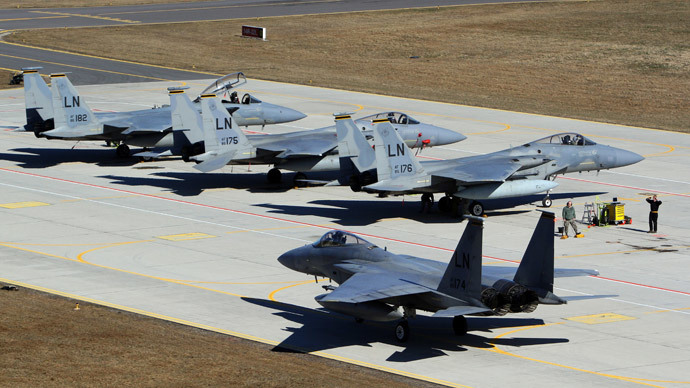NATO: Old is gold, but not always

This is not an April Fools' Day joke: at its ministerial meeting in Brussels NATO has put the brakes on all military and civilian cooperation with Moscow in a response to Russia’s actions in Ukraine.
In one fell swoop NATO bravely brushed off the dust from its old Cold War deterrence doctrine. It looked more than a coincidence, and rather an act full of symbolism, when NATO foreign ministers decided to beef up the collective security of 28 member-states to counter “Russia’s misconduct” on the eve of NATO’s 65th anniversary, unmarked by fanfare.
It is high time to recall that the North Atlantic Treaty Organization was founded four years after the end of the Second World War – on April 4, 1949, in Washington – to deter communist Russia and ‘Big Brother’s’ Eastern satellites, which were rising from the ruins of post-war Europe under Red banners, with communist mantras on their lips.
Therefore, the notorious Article 5 of the NATO Charter spelled out the principle of ‘collective defense’ – the cornerstone of European and transatlantic security as was seen by alliance’s founding-fathers, alarmed by the rise of Soviet empire and spread of its influence globally.
Ironically, in its operations in the last six-and-a-half decades the alliance has referred to the most-cherished Article 5 of its ‘Security Bible’ only once. It happened in the post-Communist world, during the US-led military operation in Afghanistan in 2001, launched by President George W. Bush shortly after September 11 to punish those responsible for deadly attacks thousands of miles away from Manhattan – in the dusty fields of sun-soaked Central Asia.
However, more than a decade later, as US and NATO military contingent was preparing for the much-awaited withdrawal from Afghanistan by the end of 2014, the alliance looked more like an ageing giant – over-bureaucratized, getting increasingly bored and lazy, losing the very sense of existence and struggling to invent its own rejuvenating ‘wonder drug’. As they said in the corridors of NATO headquarters in Brussels with years once mighty alliance transformed into another NATO – ‘No action, talk only’ (cynics inside the organization also called it ‘North Atlantic Travel Office’).
Up until the Ukrainian crisis broke out and Crimea voted at the historic referendum to sail away from Kiev and return to the Russian harbor, the question ‘What to do next after Afghanistan?’ looked like a real disaster for NATO strategists. As a result, the renewed agenda for the next NATO summit in Wales, scheduled for this September was coined in a vague formula of ‘combatting terrorism and cyber-threats’.
As the day of the Wales summit was nearing, voices in European NATO member-states, gripped by austerity and belt-tightening measures called on considerable downsizing of military budgets and reducing NATO combat potential to ‘minimal level’. They saw no reason for further defense spending as Article 5 of NATO Charter looked like an anachronism.

The controversy over NATO and its identity crisis revealed the plain truth: for survival NATO needs a good adversary. It is only the sword of Damocles threat – real or imaginary - that 65 years after its birth can give the alliance a chance to prove it can still fit into the 21st-century reality. The war in Iraq, which evoked strong reservations from US key European partners and leading NATO member-states – Germany and France proved that alliance’s former political mechanism in present-day reality can hinder US unilateral effort rather than support it. As it turned out, the most valuable US partners in Iraq were not Europeans, privately scolded as ‘dwarfs’ in Washington, but countries outside NATO ready to join US-led multinational ‘coalitions of willing’.
Meanwhile, Ukrainian crisis has put NATO machine back on track and pumped a new steam in the initial security doctrine. The newly-discovered ‘Russian threat’ has cemented NATO ranks, making alliance members to speak in one voice and show unity, rarely seen in recent years.
“Through its actions Russia has undermined the principles on which our partnership is built, and has breached its own international commitments. So we can’t go on going business as usual,” NATO Secretary-General Anders Fogh Rasmussen announced at this week NATO foreign ministers meeting in Brussels.
While some downplay Rasmussen’s harsh rhetoric on Russia calling him outgoing NATO head (he is going to be replaced by newly appointed secretary-general Jens Stoltenberg from October 1), Anders Fogh Rasmussen would still hold the NATO reins in the coming months and would preside over the Wales summit. So he will still have time to start the process of changing the NATO security doctrine, which would see Russia as a dangerous and unpredictable stranger, rather than a squabbling partner.
Well-placed diplomatic sources in Brussels say that in the wake of the new reality the agenda of the Wales summit will be drastically revamped. What is likely to come at the top of the summit agenda is not some enigmatic cyber threat from the world of computer reality, but the hastily-made security preparations in Eastern Europe and Baltic republics to deter Russia.
In an outbreak of fresh activity to show NATO is ready to rise to the ‘Russian challenge’, NATO foreign ministers in Brussels announced the main points of the new security plan. It is expected that NATO will offer regular air patrols over Baltic States, boost the number of troops and aircraft stationed at its airbase in Romania, increase its military presence in Poland, conduct large-scale military drills of its members close to Russian borders and intensify military cooperation with Ukraine.
The Eastward expansion doctrine – the bone of contention in Russia’s relations with NATO from late ’90s is well and on the table. The waiting list of potential NATO recruits includes Montenegro, Macedonia, Bosnia and Herzegovina, as well as Georgia.
Moreover, according to the leaks, the alliance members can reconsider their stand on US tactical nuclear weapons, stationed in Germany, Netherlands, Belgium, Italy and Turkey. Until the Ukrainian crisis, public opinion in these countries was calling on the authorities to remove the US nuclear arsenal from the Old Continent. However, the new standoff with Russia comes as a game-changer: it allows NATO strategists to keep their tail up advocating US nukes remaining in Europe.
Thus, it is most likely that it was not Russia, but NATO which failed to get out of the vicious circle of old stereotypes. Old is gold, but not always, as NATO experience shows.
The statements, views and opinions expressed in this column are solely those of the author and do not necessarily represent those of RT.
The statements, views and opinions expressed in this column are solely those of the author and do not necessarily represent those of RT.













